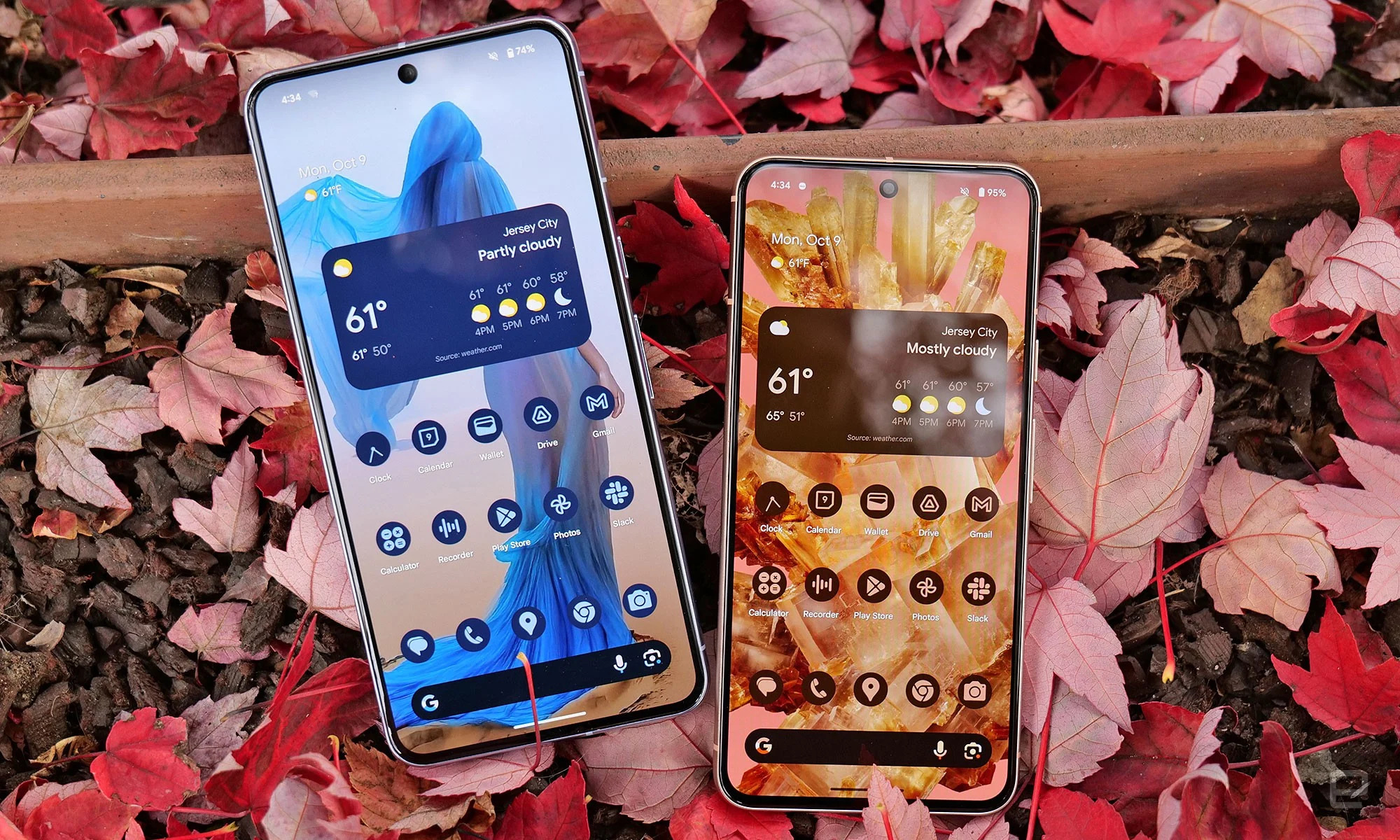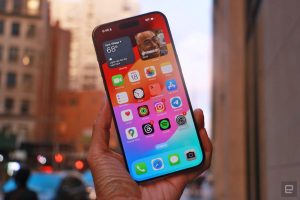Ever since the first Pixel, Google has consistently relied on its software as its unique selling point for all its phones. This is evident in various aspects, including camera technology with features such as HDR+ processing and Google’s powerful Night Sight mode. Furthermore, it extends to a broader range of features such as Call Screen, Live Translate, and the Recorder app. However, with the Pixel 8 and Pixel 8 Pro, propelled by the new Tensor G3 chip and an increased focus on machine learning, it appears that Google’s latest flagship phones are not just riding the wave of recent AI excitement but are actually transforming it into practical, user-friendly tools.
Design and display
The Pixel 8 and 8 Pro may not appear drastically different from their predecessors at first glance, but upon closer examination, you’ll notice a series of subtle tweaks and enhancements. The corners are now slightly more rounded, and Google has eliminated the small chin beneath the screen, achieving uniform bezel sizes all around. One notable change is the slight reduction in screen size for the Pixel 8, now at 6.2 inches (down from 6.3 inches on the Pixel 7). This adjustment brings the phone into a more compact and manageable form, striking a balance between size and usability, unlike the ill-fated iPhone Mini 13 (may it rest in peace).

However, it’s worth noting that while Google’s pursuit of precise, true-to-life colors, indicated by its Actua branding, offers a unique visual experience, it can sometimes result in certain hues and tones appearing slightly muted compared to rival devices. This doesn’t necessarily detract from the overall quality but might affect how, for instance, food looks on the device, which may appear more vibrant on other smartphones. Additionally, the Pixel 8 features a slightly lower resolution (2,400 x 1,080) compared to the 8 Pro (2,992 x 1,33) and has a narrower range for its variable refresh rate (60-120Hz vs. 1-120Hz).
Performance
Featuring the new Tensor G3 chip and offering either 8GB or 12GB of RAM depending on the model, the Pixel 8 and 8 Pro have noticeably improved in terms of performance compared to their predecessors. While I haven’t had the chance to run benchmark apps like Geekbench 6 due to testing these devices prior to their official release, I can confirm that games load more swiftly, and the phone exhibits increased responsiveness. However, it’s important to note that it’s not quite on par with devices equipped with the Snapdragon 8 Gen 2 chip.
One notable boost for the Pixel 8 Pro is its expanded storage support, now accommodating up to 1TB. Regrettably, the same expansion in storage capacity does not apply to the Pixel 8, which still maxes out at 256GB.

Performance isn’t solely about clock speeds and benchmarks, as Google highlights that the Tensor G3 runs more than twice the number of on-device machine learning models compared to the Pixel 6’s G1 processor. While this figure may be challenging to quantify, its significance becomes evident with the introduction of features like the Magic Editor, which employs generative AI for photo manipulation. Currently, when adjusting a photo or utilizing AI to create a new wallpaper in Android 14, there’s a noticeable two to three-second delay before results become visible. This delay is understandable considering the software’s novelty, but given the frequency of my use of these features, I eagerly anticipate enhanced performance in the future.
Cameras
The Pixel 8 showcases Google’s enhanced software and AI capabilities most prominently in the realm of photography and videography. Alongside the new sensors, such as the 50-MP main camera and a 12-MP ultra-wide lens (or a 48-MP ultra-wide and 48-MP telephoto with 5x optical zoom on the 8 Pro), the Pixel 8 offers a fresh suite of tools for elevating the quality of your captures.
One of the most remarkable additions is the Magic Editor, which combines lasso and content-aware fill functionalities, reminiscent of Photoshop, into a single, user-friendly tool. You can simply outline an element with your finger, allowing you to either remove it (handy for eliminating distracting elements) or reposition it elsewhere. The Pixel leverages AI to seamlessly fill in any gaps, making what may sound simple in theory a smooth and impressive reality. It’s worth noting that, to use Magic Editor, you’ll need to back up your image in Google Photos first. So, if you’re running low on storage or have an unreliable data connection, this might pose a minor inconvenience.

For instance, consider a recent photo I took at a wedding. Even before any edits, the image looks fantastic, underscoring Google’s exceptional image processing. With the Magic Editor, I easily removed minor distractions like a neon exit sign, redirecting the viewer’s attention to the bride and groom, where it belongs.
Additionally, for those who’ve experienced the frustration of a group photo being marred by a single person’s untimely frown, there’s the Best Take feature. Instead of relying on a single group shot and hoping for the best, Best Take analyzes a series of images, identifies individuals’ faces, and grants you the option to choose the desired expression for each person. While it’s not flawless, and depending on the photo’s composition, minor imperfections may emerge around individuals’ necks, shoulders, or hair placement. However, it’s effective enough that such imperfections might go unnoticed unless actively sought out. The key is to remember to capture more than just a single photo – a practice many photographers already follow.

Other new features
The realm of AI-powered functions extends further. Suppose you fancy crafting a custom wallpaper; in that case, you can effortlessly generate one based on a few adjustable parameters. While this approach is intriguing for producing a unique backdrop, it does occasionally suffer from the typical imperfections found in AI-generated art. For instance, my creation featured somewhat awkward-looking hands.
When you’re pressed for time, you can enlist the Google Assistant to summarize an article from the web or have it read the article aloud. This creates a new audio popup, allowing you to listen while multitasking. It’s akin to transforming any article into an audiobook, which proves exceptionally convenient. Essentially, the entire internet becomes a podcast. And if that weren’t enough, the assistant can even translate stories into another language simultaneously.
Thanks to the Tensor G3 chip, Google boasts enhanced natural voice and text recognition on the Pixel 8. This underpins features such as a proofreading tool within Gboard and improved Assistant voice typing, available across multiple languages (including English, French, German, Italian, Japanese, and Spanish). Unfortunately, since I’m only proficient in Mandarin, which isn’t currently supported, I’ll have to revisit this when it’s added.

Finally, Google incorporates a new algorithm in conjunction with upgraded hardware for Face Unlock, resulting in significantly enhanced speed and security. In my trials, this increased swiftness was evident. On a few occasions, when I placed the phone on a wireless charging pad, it automatically unlocked from a distance of six feet as I entered the room, suggesting improvements in facial recognition. However, during the setup process, I discovered that you need to be in a relatively well-lit environment, or you may encounter errors with a request to try again.
Though unrelated to AI, the Pixel 8 Pro introduces a new temperature sensor that can initially be used to measure drinks and similar items. In the future, subject to FDA approval, Google hopes to enable users to employ these sensors as thermometers for monitoring human temperature. This feature, while not essential, may prove useful, particularly for parents of young children who often worry about their child’s well-being.
Battery Life and support
The Tensor G3 chip doesn’t just supercharge the Pixel 8’s AI capabilities; it also brings an improvement in battery life. In our standard video rundown test, the Pixel 8 lasted for an impressive 20 hours and 16 minutes, a notable two-hour boost compared to last year’s model. The Pixel 8 Pro performed even better, with a lasting endurance of 21 hours and 9 minutes, as opposed to the Pixel 7 Pro’s 16 hours and 42 minutes. Furthermore, wired charging is now a tad swifter, with the Pixel 8 at 27 watts and the Pixel 8 Pro at 30 watts. Keep in mind, though, that a suitable charging brick is not included in the package and needs to be purchased separately.

However, the most significant enhancement across the entire device may be Google’s commitment to providing seven years of software and hardware support for the Pixel 8 line. This comprehensive support includes Android updates, monthly security patches, and regular feature additions, all the way until 2030. While the long-term performance of these phones remains to be seen, it’s challenging to be dissatisfied with such an extensive support commitment, making the Pixel 8 line one of the few Android phones to offer such extensive support, surpassed only by the Fairphone 5.
Wrap-up
In 2018, with the launch of the Pixel 3, Google’s software-first approach to phone design truly started to shine. Fast forward to the Pixel 8, where the Tensor G3 chip and the innovative tools it powers take Google’s AI capabilities to a new level. This isn’t just AI in the cloud; it’s tangible and practical AI right in the palm of your hand. The Pixel 8 enhances your photos, improves sound quality in videos, simplifies news consumption, and even makes sense of those perplexing drunk texts. Plus, with extended software support, the Pixel 8 holds the promise of getting even better over time.

It’s worth noting that both the Pixel 8 and 8 Pro come with a $100 price increase compared to their predecessors. However, this price hike can be attributed to inflation, and it’s in line with the industry trend. Verizon customers looking for mmWave 5G support will find that the Pixel 8 starts at $799. Nevertheless, the more affordable Pixel 8 offers an upgraded main camera, enhanced battery life, a refined design, and a host of AI tools, including the impressive Magic Editor and Best Take. Despite the price adjustment, the Pixel 8 is still an exceptional value, with the slightly smaller screen improving overall portability. It’s a nearly perfect compact Android phone.
Now, let’s talk about the Pixel 8 Pro, which takes things to the next level. Google’s phones were already renowned for capturing outstanding photos, but the Pixel 8 Pro, armed with AI and a suite of upgraded sensors, sets new standards for mobile photography. Despite using foldable phones as my daily driver for the past three years, the Pixel 8 Pro is the first device that tempts me to return to a conventional glass and metal smartphone. What truly sets the Pixel 8 and Pixel 8 Pro apart is that even if you’re not well-versed in the intricacies of AI, the allure of Google’s latest offerings is impossible to resist.




